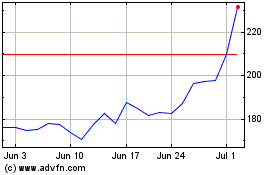By John D. Stoll, Christina Rogers and Joann S. Lubin
Looking to combat Silicon Valley's abrupt push into the car
business, Ford Chief Executive Mark Fields hired industry outsider
Jim Hackett to help tackle the issue in early 2016. Now Mr. Hackett
is taking over the corner office.
A former head of Steelcase Inc., Mr. Hackett has been chairing
Ford's "Smart Mobility" innovation unit. He will be named Ford's
new CEO as early as Monday, according to several people familiar
with the matter. The shuffle ends Mr. Field's three-year tenure at
the Dearborn, Mich., auto maker's helm and caps a 28-year career at
the company during which he developed a reputation as a
hard-charging leader.
The board began discussing the move earlier in 2017, a year
during which the auto industry icon's stock price slipped behind
Palo Alto, Calif., electric-vehicle startup Tesla Inc. The Tesla
development, along with tension amid the management ranks, shook
directors' confidence in the strategy and direction, according to
people familiar with the deliberations.
Mr. Hackett is known for clear communication and taking bold
action, and recently made big waves in the Detroit area when as
interim athletic director for the University of Michigan he
famously recruited NFL coach Jim Harbaugh to lead Michigan's
football program. He most recently oversaw the formation of Ford
Smart Mobility, a unit responsible for experimenting with
car-sharing programs, self-driving ventures and other programs
aimed at helping the 114-year-old auto maker better compete with
Uber Technologies Inc., Alphabet Inc. and other tech giants looking
to edge in on the auto industry.
The Wall Street Journal reported the board's deliberations on a
management shake-up Sunday evening. A Ford spokeswoman declined to
comment on the move--Messrs. Fields and Hackett couldn't
immediately be reached.
Jim Farley, recruited by Ford from Toyota Motor Corp. and
credited with turning around European operations, will also be
given a new prominent role. Mr. Farley, 54, will work directly
under the 62-year-old Mr. Hackett as a potential successor,
according to multiple people briefed on Ford's plans.
A group of other executives will be reassigned.
Mr. Hackett is a one-time Ford board member known for an easy
and straightforward style reminiscent of Alan Mulally, a longtime
Boeing Co. executive recruited to run Ford in 2006. Mr. Mulally
addressed the turmoil that permeated Ford's management ranks at the
time, sold off business units and shored up the balance sheet.
Mr. Mulally left Ford in 2014 as the company was on a winning
streak, benefiting from a revamped product line that was built
while avoiding the bankruptcies that claimed its Detroit rivals
General Motors Co. and Fiat Chrysler Automobiles NV's Chrysler unit
in 2009. Mr. Fields, a turnaround artist known for overseeing
revivals in Ford's operations on several continents and within
various business units, was a top lieutenant under Mr. Mulally and
Chairman Bill Ford's pick as the successor.
The company's board and Mr. Ford, however, began discussing
changes to the leadership team recently as the share price hovered
around $11 a share--nearly 40% lower than when Mr. Fields took
over. When the market capitalizations of Ford and GM were
individually surpassed by automotive upstart Tesla Inc.'s earlier
in this year, it underscored how far behind Detroit is perceived to
be in the race to develop new technology.
One of several auto-industry outsiders recruited by Mr. Fields,
Mr. Hackett was installed to be instrumental in helping Ford's
moves into transportation-related services. Auto executives are
confronting changing attitudes toward car ownership. Uber, Google,
Tesla and others are racing ahead with programs aimed at overtaking
Detroit as the tope of the U.S. car industry.
Those programs include electric vehicles, ride-hailing services
and programs aimed at putting vehicles on the road entirely capable
of driving without human intervention. Mr. Fields has been planning
to launch driverless cars early next decade, but it has been far
behind Tesla and GM on electric-car development and executives have
struggled to explain how Ford will make money on services other
than developing, producing and selling automobiles.
Ford has posted a series of solid profits under Mr. Fields,
aided by renewed demand for pickups and sport utilities that
deliver higher margins and do well in an era of cheap gasoline. Mr.
Farley, meanwhile, helped deliver more than $1 billion in profit in
Europe last year, with the favorable result coming as GM exited
that region due to persistent losses and a lack of confidence in
its German Opel unit.
Mr. Fields, however, has struggled with Wall Street. Analysts
and investors have routinely questioned the company's ability to
weather the next industry downturn--criticism has increased as U.S.
auto sales plateau and Ford's market share slides.
Over 30 years at Steelcase, Mr. Hackett reshaped the company's
workplace offerings, dispensing with cubicles and embracing open
offices.
In an interview with The Wall Street Journal last year, Mr.
Hackett said he wasn't interested in being a CEO again but was
interested in helping Mr. Fields think through tough
challenges.
During the interview, Mr. Hackett explained that traditional
car-building consumes substantial capital and returns relatively
slim margins. In so-called mobility services, he said Ford could
eventually earn far more attractive margins if it hired the right
software engineers and designers.
The auto maker has been projecting 20% margins in the mobility
services business, but hasn't outlined when that will be. Ford's
North American unit is the most profitable it currently runs, and
it returns about 10% operating margins under the best
conditions.
Ford's Smart Mobility unit has made some initial moves under Mr.
Hackett's direction. For instance, it hired van-shuttle service
Chariot and joined up with a bike-sharing firm.
Write to John D. Stoll at john.stoll@wsj.com and Christina
Rogers at christina.rogers@wsj.com
(END) Dow Jones Newswires
May 22, 2017 06:32 ET (10:32 GMT)
Copyright (c) 2017 Dow Jones & Company, Inc.
Tesla (NASDAQ:TSLA)
Historical Stock Chart
From Mar 2024 to Apr 2024

Tesla (NASDAQ:TSLA)
Historical Stock Chart
From Apr 2023 to Apr 2024
